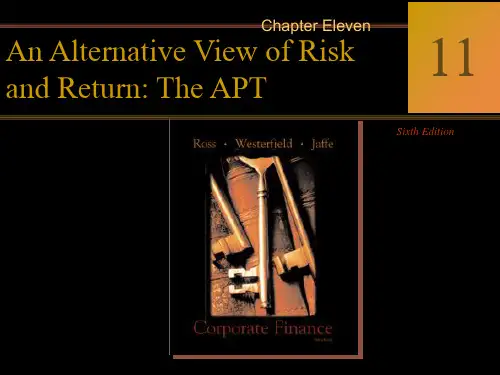公司理财英文版课件Chap011
- 格式:ppt
- 大小:680.00 KB
- 文档页数:28

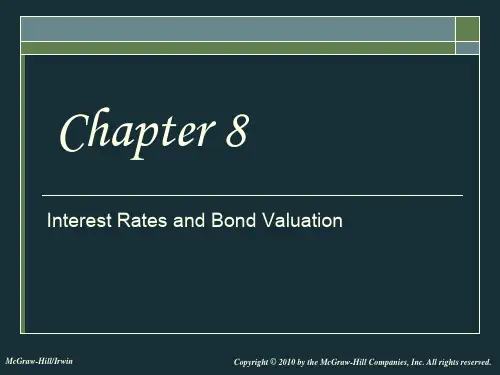
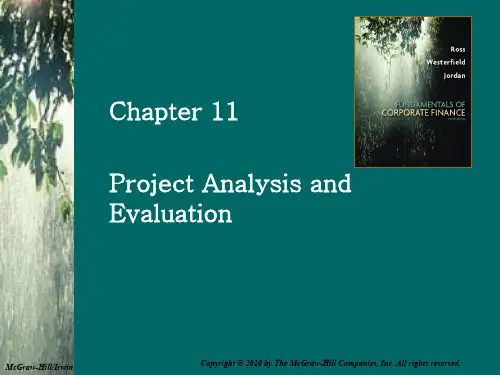

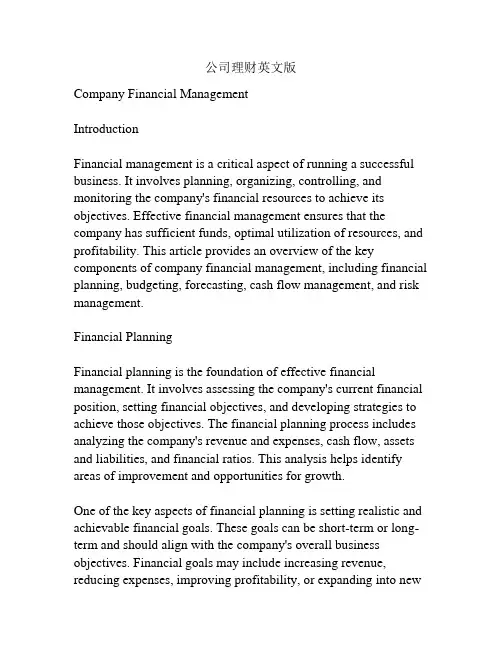
公司理财英文版Company Financial ManagementIntroductionFinancial management is a critical aspect of running a successful business. It involves planning, organizing, controlling, and monitoring the company's financial resources to achieve its objectives. Effective financial management ensures that the company has sufficient funds, optimal utilization of resources, and profitability. This article provides an overview of the key components of company financial management, including financial planning, budgeting, forecasting, cash flow management, and risk management.Financial PlanningFinancial planning is the foundation of effective financial management. It involves assessing the company's current financial position, setting financial objectives, and developing strategies to achieve those objectives. The financial planning process includes analyzing the company's revenue and expenses, cash flow, assets and liabilities, and financial ratios. This analysis helps identify areas of improvement and opportunities for growth.One of the key aspects of financial planning is setting realistic and achievable financial goals. These goals can be short-term or long-term and should align with the company's overall business objectives. Financial goals may include increasing revenue, reducing expenses, improving profitability, or expanding into newmarkets. Setting specific, measurable, attainable, relevant, and time-bound (SMART) goals enhances the effectiveness of financial planning.BudgetingBudgeting is an integral part of financial management as it helps allocate financial resources effectively. A budget is a comprehensive plan that outlines the company's expected revenue and expenses for a specific period, typically a year. It serves as a roadmap for financial decision-making and helps control spending, ensure profitability, and allocate resources efficiently.The budgeting process involves gathering relevant financial data, estimating revenue and expenses, and projecting cash flows. The budget should be realistic, achievable, and aligned with the company's financial goals. It should also be flexible enough to adapt to changing circumstances and market conditions. Regular monitoring and review of the budget help identify variances and take corrective actions if necessary.ForecastingForecasting is an essential component of financial management as it helps anticipate future financial trends and outcomes. It involves analyzing historical data, market trends, and economic indicators to predict the company's financial performance. Forecasting enables companies to make informed decisions, identify potential risks and opportunities, and develop strategies to mitigate risks and exploit opportunities.Cash Flow ManagementCash flow management is crucial for the financial stability and success of a company. It involves monitoring and controlling the company's cash inflows and outflows to ensure sufficient liquidity and meet financial obligations. Effective cash flow management minimizes the risk of cash shortages, improves financial flexibility, and enhances the company's ability to invest in growth opportunities.To manage cash flow effectively, companies need to accurately forecast cash inflows from sales, investments, and financing activities. They also need to monitor and control cash outflows, including payments to suppliers, employee salaries, and loan repayments. Efficient working capital management, such as optimizing inventory levels and extending payment terms with suppliers, can help improve cash flow.Risk ManagementRisk management is an integral part of company financial management. It involves identifying, assessing, and mitigating financial risks that may impact the company's financial stability and performance. Some common financial risks include market risks, credit risks, liquidity risks, and operational risks.To manage financial risks effectively, companies need to develop robust risk management strategies and processes. This includes diversifying investments, hedging against currency or interest ratefluctuations, implementing internal controls and governance structures, and having effective insurance coverage. Regular monitoring and review of risk management strategies help ensure their effectiveness and relevance in the changing business environment.ConclusionEffective financial management is crucial for the success of any company. It involves planning, budgeting, forecasting, cash flow management, and risk management. Financial planning helps set realistic and achievable financial goals, while budgeting allocates financial resources effectively. Forecasting helps anticipate future financial trends and outcomes, and cash flow management ensures sufficient liquidity. Lastly, risk management mitigates financial risks that may impact the company's financial stability and performance. By implementing sound financial management practices, companies can improve profitability, maximize shareholder value, and achieve long-term sustainability.。
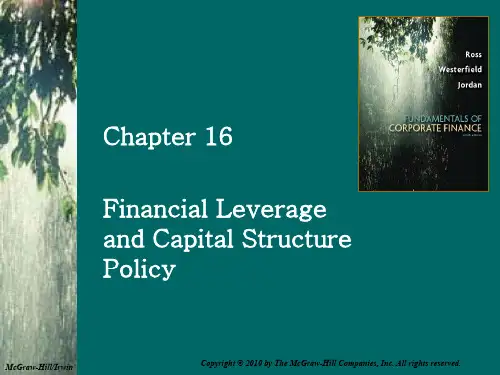
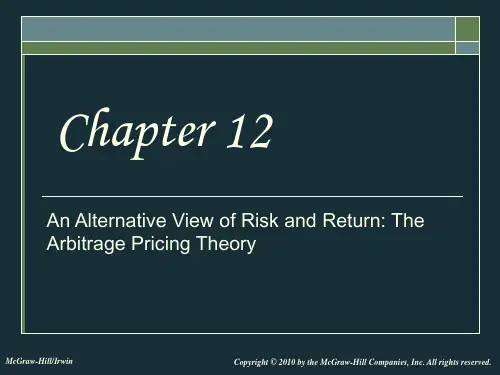
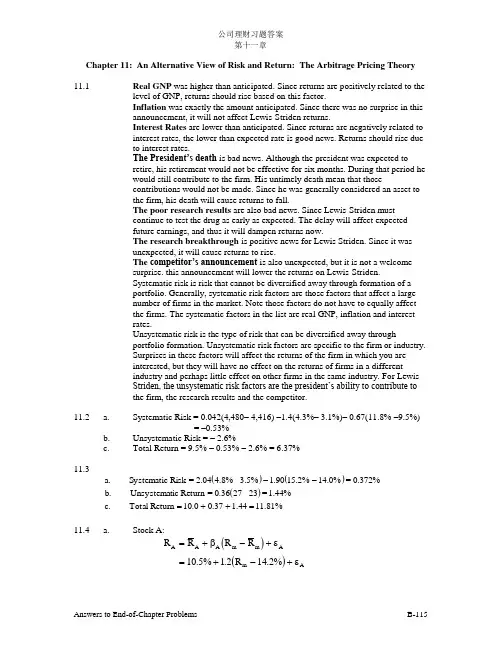
公司理财习题答案第十一章Chapter 11: An Alternative View of Risk and Return: The Arbitrage Pricing Theory 11.1 Real GNP was higher than anticipated. Since returns are positively related to the level of GNP, returns should rise based on this factor.Inflation was exactly the amount anticipated. Since there was no surprise in this announcement, it will not affect Lewis-Striden returns.Interest Rates are lower than anticipated. Since returns are negatively related to interest rates, the lower than expected rate is good news. Returns should rise due to interest rates.The President’s death is bad news. Although the president was expected to retire, his retirement would not be effective for six months. During that period he would still contribute to the firm. His untimely death mean that thosecontributions would not be made. Since he was generally considered an asset to the firm, his death will cause returns to fall.The poor research results are also bad news. Since Lewis-Striden must continue to test the drug as early as expected. The delay will affect expected future earnings, and thus it will dampen returns now.The research breakthrough is positive news for Lewis Striden. Since it was unexpected, it will cause returns to rise.The competitor’s announcement is also unexpected, but it is not a welcome surprise. this announcement will lower the returns on Lewis-Striden.Systematic risk is risk that cannot be diversified away through formation of a portfolio. Generally, systematic risk factors are those factors that affect a large number of firms in the market. Note those factors do not have to equally affect the firms. The systematic factors in the list are real GNP, inflation and interest rates.Unsystematic risk is the type of risk that can be diversified away throughportfolio formation. Unsystematic risk factors are specific to the firm or industry. Surprises in these factors will affect the returns of the firm in which you are interested, but they will have no effect on the returns of firms in a different industry and perhaps little effect on other firms in the same industry. For Lewis- Striden, the unsystematic risk factors are the president’s ability to contribute to the firm, the research results and the competitor.11.2 a. Systematic Risk = 0.042(4,480– 4,416) –1.4(4.3%– 3.1%)– 0.67(11.8% –9.5%) = –0.53% b. Unsystematic Risk = – 2.6%c. Total Return = 9.5% – 0.53% – 2.6% = 6.37%11.3 ()()()11.81%1.440.3710.0Return Total c.1.44%=23-270.36=Return ic Unsystemat b.0.372%=14.0%15.2%1.903.5%-4.8%2.04=Risk Systematic a.=++=--11.4 a. Stock A:()()R R R R R A A A m m Am A =+-+=+-+βεε105%12142%...Stock B:()()R R R R R B B m m Bm B=+-+=+-+βεε130%098142%...Stock C:()R R R R R C C C m m Cm C=+-+=+-+βεε157%137142%)..(.b.()[]()[]()[]()()()()()()[]()()CB A m cB A m c m B m A m CB A P 25.045.030.0%2.14R 1435.1%925.1225.045.030.0%2.14R 37.125.098.045.02.130.0%7.1525.0%1345.0%5.1030.0%2.14R 37.1%7.1525.0%2.14R 98.0%0.1345.0%2.14R 2.1%5.1030.0R 25.0R 45.0R 30.0R ε+ε+ε+-+=ε+ε+ε+-+++++=ε+-++ε+-++ε+-+=++= c.i.()R R R A B C =+-==+-==+-=105%1215%142%)1113%09815%142%)137%157%13715%142%168%..(..46%.(......ii.R P =+-=12925%1143515%142%)138398%..(..11.5 a.Since five stocks have the same expected returns and the same betas, the portfolio also has the same expected return and beta.()R F F E E E E E p =+++++++110084169151212345...b.公司理财习题答案第十一章R F F E N E N E NAs N s are fini F F p N =++++++→∞→=++1100841690110084169121212......,...,1Nbut E te,Thus, R j p11.6To determine which investment investor would prefer, you must compute the variance of portfolios created by many stocks from either market. Note, because you know that diversification is good, it is reasonable to assume that once an investor chose the market in which he or she will invest, he or she will buy many stocks in that market. Known:E EF ====001002 and and for all i.i σσεε..Assume: The weight of each stock is 1/N; that is, X N i =1/for all i.If a portfolio is composed of N stocks each forming 1/N proportion of the portfolio, thereturn on the portfolio is 1/N times the sum of the returns on the N stocks. Recall that thereturn on each stock is 0.1+βF+ε.()()()()()()[]()()()()()()()[]()[]()[]()()[]()()()()()j i 2j i 22j i i 2222222222P P P P iP ,0.04Corr 0.01,Cov s =isvariance the ,N as limit In the ,Cov 1/N 1s 1/N s )(1/N 1/N F 2F E 1/N F E 0.10.1/N F 0.1E R E R E R Var 0.101/N 00.1E 1/N F E 0.11/N F 0.1E R E 1/N F 0.1F 0.1(1/N)R 1/N R εε+β=εε+β∞⇒εε-+ε+β=ε∑+εβ+β=ε+β=-ε+β+=-==+β+=ε+β+=ε∑+β+=ε+β+=ε+β+==∑∑∑∑∑∑∑∑()()()()()()Thus,F R f E R E R Var R Corr Var R Corr ii ip P p i j PijR 1i =++=++===+=+010*********002250040002500412212111222.........,,εεεεεεa.()()()()Corr Corr Var R Var R i j i j p pεεεε112212000225000225,,..====Since Var ()()R p 1 Var R 2p 〉, a risk averse investor will prefer to invest in the second market.b.Corr ()()εεεε112090i j j ,.,== and Corr 2i()()Var R Var R pp120058500025==..Since Var ()()risk a ,R V ar R 2p p 1〉averse investor will prefer to invest in the second market.c.()()()()Corr Var R Var R i j j p pεεεε112120050022500225,,...==== and Corr 2i Since ()()Var R Var R p p12=, a risk averse investor will be indifferentbetween investing in the two market.d. Indifference implies that the variances of the portfolio in the two marketsare equal.()()()()()()Var R Var R Corr Corr Corr Corr p pijij ijij1211222211002250040002500405=+=+=+..,..,,,.εεεεεεεε公司理财习题答案第十一章This is exactly the relationship used in part c.11.7()()()()()()()()()()()() 2.7225%1.211.5s 1.7424%1.211.2s 0.5929%1.210.7s R Var R Var 0/N Var ,N As i.b.22.30%0.22304.9725/100s 4.9725%2.251.211.5s 17.84%0.17843.1824/100s 3.1824%1.441.211.2s 12.62%1.5929/100s 1.5929%1.001.210.7s Var R Var R Var a.22C 22B 22A m 2i i j C 22C B 2B 2A 2A 2i m 2i j ======β=∴→ε∞→===⇒=+====⇒=+===⇒=+=∴ε+β=ii. APT Model: ()R R R R i F m F i =+-β%25.14)5.1)(3.36.10(3.3R %06.12)2.1)(3.36.10(3.3R %41.8)7.0)(3.36.10(3.3R C B A =-+==-+==-+= APT Model shows that assets A & B are accurately priced but asset C is overpriced. Thus, rational investors will not hold asset C.iii. If short selling is allowed, all rational investors will sell short asset C so that the price of asset C will decrease until no arbitrage opportunity exists. In other words, price of asset C should decrease until the returnbecome 14.25%.11.8 a. Let X= the proportion of security of one in the portfolio and (1-X) = theproportion of security two in the portfolio.()()[]()()[]t 222t 121t 2t 212t 111t 1t2t 1pt F F R E x 1F F R E x R X 1XR R β+β+-++β+=-+=The condition that the return of the portfolio does not depend on F 1implies:()05.0)X 1(X 0X 1X 2111=-+=β-+βThus, P=(-1,2); i.e. sell short security one and buy security two.()()()()()()5.2225.11%20%202%201R E 2p p =+-=β=+-=b. Follow the same logic as in part a, we have()()3X 05.1X 1X 0X 1X 4131==-+=β-+βWhere X is the proportion of security three in the portfolio. Thus, sell short security four and buy security three.()()()()()()075.025.03%10%102%103R E 2p p =-=β=-+=this is a risk free portfolio!c. The portfolio in part b provides a risk free return of 10% which is higher than the 5% return provided by the risk free security. To take advantage of this opportunity, borrow at the risk free rate of 5% and invest the funds in a portfolio built by selling short security four and buying security three with weights (3,-2).d. Assuming that the risk free security will not change. The price of security four ( that everyone is trying to sell short) will decrease and the price of security three ( that everyone is trying to buy ) will increase. Hence the return of security four will increase and the return of security three will decrease.The alternative is that the prices of securities three and four will remain the same, and the price of the risk-free security drops until its return is 10%.Finally, a combined movement of all security prices is also possible. The prices of security four and the risk-free security will decrease and the price of security four will increase until the opportunity disappears.E ()R j20%10% 5%()ββ1210i =2.5。
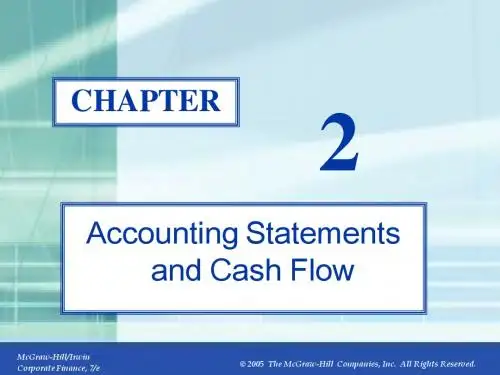
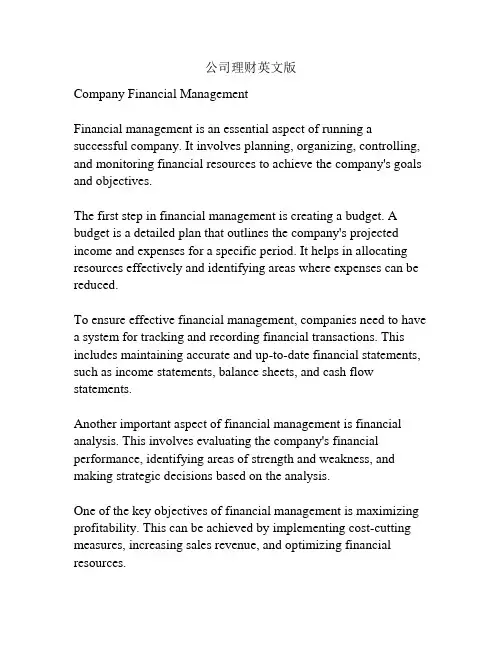
公司理财英文版Company Financial ManagementFinancial management is an essential aspect of running a successful company. It involves planning, organizing, controlling, and monitoring financial resources to achieve the company's goals and objectives.The first step in financial management is creating a budget. A budget is a detailed plan that outlines the company's projected income and expenses for a specific period. It helps in allocating resources effectively and identifying areas where expenses can be reduced.To ensure effective financial management, companies need to have a system for tracking and recording financial transactions. This includes maintaining accurate and up-to-date financial statements, such as income statements, balance sheets, and cash flow statements.Another important aspect of financial management is financial analysis. This involves evaluating the company's financial performance, identifying areas of strength and weakness, and making strategic decisions based on the analysis.One of the key objectives of financial management is maximizing profitability. This can be achieved by implementing cost-cutting measures, increasing sales revenue, and optimizing financial resources.Companies also need to manage their cash flow effectively. This includes monitoring cash inflows and outflows, ensuring there is enough cash to cover expenses and investments, and managing short-term liquidity.In addition, companies need to consider long-term financial planning. This involves setting financial goals and developing strategies to achieve them, such as investment planning and capital structure management.Risk management is another important aspect of financial management. Companies need to identify and analyze potential risks, such as financial market volatility, credit risk, and operational risks, and implement strategies to mitigate them. Ultimately, effective financial management is crucial for the success and sustainability of a company. It helps in making informed decisions, maximizing profitability, and ensuring financial stability.。
